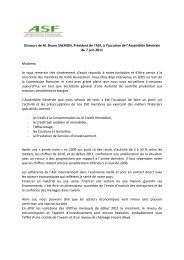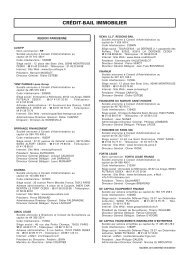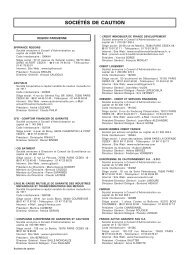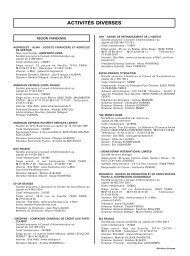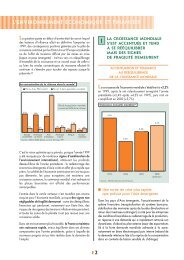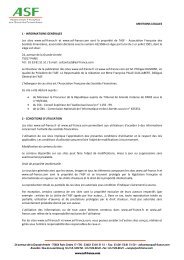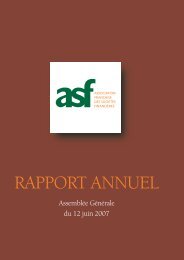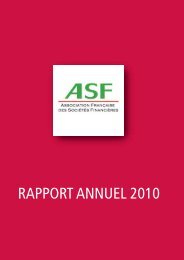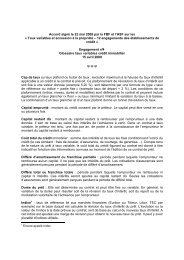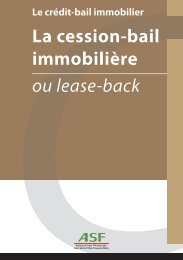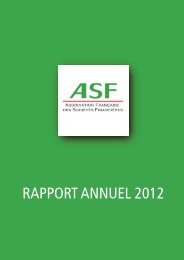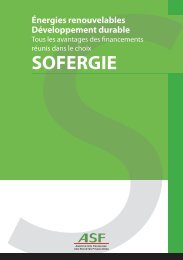Factoring in France : 10 questions / 10 answers - ASF
Factoring in France : 10 questions / 10 answers - ASF
Factoring in France : 10 questions / 10 answers - ASF
You also want an ePaper? Increase the reach of your titles
YUMPU automatically turns print PDFs into web optimized ePapers that Google loves.
<strong>Factor<strong>in</strong>g</strong> <strong>in</strong> <strong>France</strong><strong>10</strong> <strong>questions</strong>/<strong>10</strong> <strong>answers</strong>
Contents1. What is factor<strong>in</strong>g?2. Who is factor<strong>in</strong>g aimed at?3. Why choose factor<strong>in</strong>g?4. When do you need factor<strong>in</strong>g?5. How does it work?6. How does factor<strong>in</strong>g fit <strong>in</strong>to relationshipswith exist<strong>in</strong>g partners?7. What are the different types of factor<strong>in</strong>g?8. <strong>Factor<strong>in</strong>g</strong> and exports?9. What is the charg<strong>in</strong>g basis?<strong>10</strong>. How is factor<strong>in</strong>g set up?<strong>10</strong> <strong>questions</strong> <strong>10</strong> <strong>answers</strong>/<strong>Factor<strong>in</strong>g</strong> <strong>in</strong> <strong>France</strong>
1. What is factor<strong>in</strong>g?<strong>Factor<strong>in</strong>g</strong> is a solution for manag<strong>in</strong>g companies’ trade receivables.It provides them with f<strong>in</strong>anc<strong>in</strong>g which can complementor take the place of conventional bank facilities.<strong>Factor<strong>in</strong>g</strong> is based on the assignment of trade receivables to aspecialist company, the factor, which enables the company tomeet its cash flow requirements while receiv<strong>in</strong>g support <strong>in</strong> allits development phases.<strong>Factor<strong>in</strong>g</strong> therefore <strong>in</strong>cludes a customer payment guarantee,collection and management of payments.It <strong>in</strong>troduces <strong>in</strong>formation and credit <strong>in</strong>surance mechanisms <strong>in</strong>tothe management of trade receivables, offer<strong>in</strong>g a flexible solutionwhich provides a source of liquidity meet<strong>in</strong>g the evolv<strong>in</strong>g needsof the company.
2. Who is factor<strong>in</strong>g aimed at?<strong>Factor<strong>in</strong>g</strong> is aimed at all companies trad<strong>in</strong>g with other companiesor public-sector bodies, whatever their size and sector ofactivity, whether or not they are engaged <strong>in</strong> exports.The grow<strong>in</strong>g need for competitiveness <strong>in</strong>creas<strong>in</strong>gly emphasisesthe advantages of outsourc<strong>in</strong>g the management of tradereceivables, allow<strong>in</strong>g better concentration on core bus<strong>in</strong>ess,rais<strong>in</strong>g the quality of services offered to customers and fulfill<strong>in</strong>gcommercial objectives more effectively.At the same time, the company’s efficiency <strong>in</strong>creases andmanagement and production costs are reduced or stabilised.The factor enables receivables to be turned <strong>in</strong>to cash as they falldue and costs to be kept under control.<strong>10</strong> <strong>questions</strong> <strong>10</strong> <strong>answers</strong>/<strong>Factor<strong>in</strong>g</strong> <strong>in</strong> <strong>France</strong>
3. Why choose factor<strong>in</strong>g?Secur<strong>in</strong>g and f<strong>in</strong>anc<strong>in</strong>g trade receivables is one of the ma<strong>in</strong>preoccupations of bus<strong>in</strong>ess managers.Effective management of these receivables is therefore essential <strong>in</strong>order to:• develop sales;• while reduc<strong>in</strong>g the costs and risks associated with collectiontimes and bad debts.<strong>Factor<strong>in</strong>g</strong> is a durable solution for the provision of shorttermf<strong>in</strong>ance, <strong>in</strong>corporat<strong>in</strong>g risk prevention, rapid f<strong>in</strong>anc<strong>in</strong>g ofreceivables, monitor<strong>in</strong>g, follow-up and account management. Byoutsourc<strong>in</strong>g the management of trade receivables, the companyga<strong>in</strong>s three key strengths:• conversion of fixed costs <strong>in</strong>to variable costs;• optimised adm<strong>in</strong>istration;• secure f<strong>in</strong>ancial management.Trade receivables represent on average40% of a company’s assets.
4. When do you need factor<strong>in</strong>g?The company can benefit from the use of factor<strong>in</strong>g at each stage<strong>in</strong> its development.In the start-up phase, f<strong>in</strong>anc<strong>in</strong>g receivables through a factor mayovercome a shortfall of cash flow or bank facilities.In the maturity and revenue-growth phase, there are various reasonsfor us<strong>in</strong>g the services of a factor: protection aga<strong>in</strong>st customerfailures, relief from adm<strong>in</strong>istrative tasks or f<strong>in</strong>anc<strong>in</strong>g of growth.F<strong>in</strong>ally, <strong>in</strong> the case of export bus<strong>in</strong>ess, the factor supports thecompany by provid<strong>in</strong>g it with the same services as <strong>in</strong> the domesticmarket.<strong>10</strong> <strong>questions</strong> <strong>10</strong> <strong>answers</strong>/<strong>Factor<strong>in</strong>g</strong> <strong>in</strong> <strong>France</strong>
5. How does it work?You sign a contract with your factor<strong>in</strong>g company (factor).1. Your customer places an order.2. You send a request to your factor. Your factor analyses it andgrants you a guarantee l<strong>in</strong>e cover<strong>in</strong>g you aga<strong>in</strong>st the risk of<strong>in</strong>solvency on the part of your customer. Your customer isgenerally notified, by you and by the factor, that he must settlethe <strong>in</strong>voices directly with the factor<strong>in</strong>g company.3. You deliver the goods or provide the service.4. You <strong>in</strong>voice your purchaser.5. You assign your receivables to the factor<strong>in</strong>g company. This assignmentmay be paperless.6. Your factor will generally advance up to 90% of the tax-<strong>in</strong>clusiveamount of the assigned receivables, with<strong>in</strong> 48 hours. Therema<strong>in</strong>der is used to create a guarantee fund.7. Your factor carries out the follow-up and collection activities untilpayment is received.* Your customer = your purchaser, your debtor
6. How does factor<strong>in</strong>g fit <strong>in</strong>to relationshipswith exist<strong>in</strong>g partners?With customersThe company ma<strong>in</strong>ta<strong>in</strong>s exclusivity <strong>in</strong> its commercial relationshipswith its customers.Freed from the need to pursue collections, it can strengthen itsl<strong>in</strong>ks with customers and concentrate on its development.With the credit <strong>in</strong>surerIf the company already has credit <strong>in</strong>surance, the factor works <strong>in</strong>partnership with the <strong>in</strong>surer.With banks<strong>Factor<strong>in</strong>g</strong> widens the sources of short-term f<strong>in</strong>ance beyondtraditional f<strong>in</strong>anc<strong>in</strong>g products.Part of the f<strong>in</strong>anc<strong>in</strong>g provided by a factor can take the form of promissorynotes.The company then has the possibility of ma<strong>in</strong>ta<strong>in</strong><strong>in</strong>g the utilisationof its discount l<strong>in</strong>es with its bank partners, who will readilyaccept the prime paper issued by the factor and will do so onattractive terms.Bank relationships are thereby ma<strong>in</strong>ta<strong>in</strong>ed or even strengthened.The bus<strong>in</strong>esses are complementary while reta<strong>in</strong><strong>in</strong>g their dist<strong>in</strong>ctivefeatures.In many cases, the bank fulfils an advisory role <strong>in</strong> direct<strong>in</strong>gclients to a factor to enable them to take advantageof the full range of guarantee and management services.<strong>10</strong> <strong>questions</strong> <strong>10</strong> <strong>answers</strong>/<strong>Factor<strong>in</strong>g</strong> <strong>in</strong> <strong>France</strong>
7. What are the different typesof factor<strong>in</strong>g?The factor<strong>in</strong>g contract can take different forms, <strong>in</strong> order to meetthe specific requirements of the company, its activity and its customers.The most common forms, apart from conventional factor<strong>in</strong>gdescribed above, are:Non-disclosed factor<strong>in</strong>g with delegated management, known as“Confidential factor<strong>in</strong>g”This factor<strong>in</strong>g technique is aimed at companies generat<strong>in</strong>g highrevenues and hav<strong>in</strong>g:• a solid f<strong>in</strong>ancial structure;• recognised technical and adm<strong>in</strong>istrative capabilities;• an efficient IT system.The company reta<strong>in</strong>s full control of the management of its receivables,and the existence of the factor<strong>in</strong>g contract is not disclosed to customers.Payments are sent to the company and credited to an account held<strong>in</strong> the company’s name at one of its banks. The factor provides thecash and the guarantee.Reverse factor<strong>in</strong>gThe company (the pr<strong>in</strong>cipal) gives advance <strong>in</strong>structions to the factorto pay its suppliers when their <strong>in</strong>voices have been passed for payment.The suppliers sign an agreement giv<strong>in</strong>g the factor prior authorisationto pay on behalf of the company. The company can take advantageof a commercial discount from its supplier. The suppliers <strong>in</strong>voice thecompany (<strong>in</strong> hard copy or electronically). The company forwards the<strong>in</strong>voices to its factor together with the associated payment authorisations.It reimburses the factor on the normal due dates of the <strong>in</strong>voices.Export factor<strong>in</strong>g (see question 8)
8. <strong>Factor<strong>in</strong>g</strong> and exports?Export factor<strong>in</strong>g enables the company to delegate the managementof export receivables.The factor either has local companies or correspondents, or multil<strong>in</strong>gualpersonnel, who are fully conversant with the specific characteristicsof <strong>in</strong>ternational trade.The company’s export receivables are guaranteed aga<strong>in</strong>st therisk of bad debts on the part of a customer.It benefits from:• monitor<strong>in</strong>g by country, customer and <strong>in</strong>voice;• management and repatriation of collected funds;• collection of export receivables, even hedg<strong>in</strong>g of currency risk.The factor provides the company with flexible, upgradeable andimmediate f<strong>in</strong>anc<strong>in</strong>g of its <strong>in</strong>ternational receivables.The company receives f<strong>in</strong>anc<strong>in</strong>g <strong>in</strong> euros or other currencies,whatever the <strong>in</strong>voice currency.<strong>10</strong> <strong>questions</strong> <strong>10</strong> <strong>answers</strong>/<strong>Factor<strong>in</strong>g</strong> <strong>in</strong> <strong>France</strong>
9. What is the charg<strong>in</strong>g basis?The factor’s services are remunerated through two ma<strong>in</strong> components,which are def<strong>in</strong>ed <strong>in</strong> the contract with the company:• The factor<strong>in</strong>g (or service) commission provides remunerationfor the management operations: record<strong>in</strong>g and monitor<strong>in</strong>g of<strong>in</strong>voices, debtor follow-up and dispute process<strong>in</strong>g, letter cod<strong>in</strong>gof payments and their remittance to the bank, return of customeraccount<strong>in</strong>g documents. The cost of the guarantee aga<strong>in</strong>st<strong>in</strong>solvency, if met by the factor, is <strong>in</strong>cluded <strong>in</strong> the factor<strong>in</strong>g commission.• The f<strong>in</strong>anc<strong>in</strong>g commission, based on a bank reference rate, iscalculated <strong>in</strong> accordance with the amount and period of f<strong>in</strong>anc<strong>in</strong>grequested.These two components may be subject to additional chargesdepend<strong>in</strong>g on the services offered by each factor.<strong>Factor<strong>in</strong>g</strong> essentially <strong>in</strong>cludes the service commission,which pays for the management operations, and the f<strong>in</strong>anc<strong>in</strong>gcommission, which pays for the cash advance.
<strong>10</strong>. How is factor<strong>in</strong>g set up?After the contract has been signed, the company forwardsduplicates of its <strong>in</strong>voices to the factor on a regular basis, forexample every week. This can be carried out electronically or bypost.Except <strong>in</strong> the case of “confidential” factor<strong>in</strong>g, a subrogation noticesupplied by the factor must appear on the company’s <strong>in</strong>voices,and its customers are <strong>in</strong>formed that they must send their paymentto the factor.For each new customer, the company opens a purchaser accountwith the factor and requests a limit up to which the commercialtransactions <strong>in</strong> respect of that customer will be guaranteed.Most factors offer onl<strong>in</strong>e services enabl<strong>in</strong>g the company to monitor allits operations: guarantees provided, payments received or disputesdetected by the factor, f<strong>in</strong>anceable amount provided etc.F<strong>in</strong>ally, the company has a dedicated contact for all its factor<strong>in</strong>goperations.To take advantage of factor<strong>in</strong>g, the company <strong>in</strong>cludes asubrogation notice on its <strong>in</strong>voices and forwards copiesof <strong>in</strong>voices to the factor. By means of onl<strong>in</strong>e services itcan then request f<strong>in</strong>anc<strong>in</strong>g and monitor its customers’payment status.<strong>10</strong> <strong>questions</strong> <strong>10</strong> <strong>answers</strong>/<strong>Factor<strong>in</strong>g</strong> <strong>in</strong> <strong>France</strong>
<strong>Factor<strong>in</strong>g</strong> companies, like banks, are credit <strong>in</strong>stitutions governedby the Bank<strong>in</strong>g Act of 24 January 1984.In that regard they must be authorised and are subject to supervisionby the national bank<strong>in</strong>g regulator. They are therefore boundby bank<strong>in</strong>g regulations which require <strong>in</strong> particular that theycomply with cover and risk-division ratios.Almost all factor<strong>in</strong>g companies are part of major groups.This <strong>in</strong>formation has been provided on the <strong>in</strong>itiative of the membersof the Section Affacturage de l’Association Française des Sociétés F<strong>in</strong>ancières(<strong>Factor<strong>in</strong>g</strong> Section of the French Association of F<strong>in</strong>ancial Companies),the professional body of f<strong>in</strong>ance specialists, which <strong>in</strong>cludes allfactor<strong>in</strong>g companies.A regularly updated list of factor<strong>in</strong>g companiescan be found on the <strong>ASF</strong> website:www.asf-france.com
24, avenue de la Grande Armée75854 Paris cedex 17, <strong>France</strong>Tel.: +33 (0)1 53 81 51 51 – Fax: +33 (0)1 53 81 51 50Website: www.asf-france.com E-mail: asf@asf-france.comBrussels: Rue du Luxembourg 19-21 B <strong>10</strong>00Tel.: 32 2 506 88 20 – Fax: 32 2 506 88 25 europe@asf-france.com



